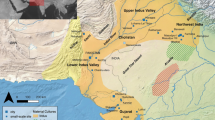Abstract
Narratives of Long Island’s past continue to efface the many Native American, African, and mixed-heritage workers from its plural past. Many of the homes and farms White families shared with their coerced, waged, and non-White workers remain rife with archaeological potential, yet archaeologists are reluctant to excavate them, presumably because of their ambiguity and lack of culturally distinct data. This article examines changing labor relations in order to repopulate these plural sites and give meaning to the many objects, practices, and spaces diverse people shared on a daily basis. An 18th- and 19th-century farmstead provides the context. Specifically, domestic architecture and activities are traced across the transition from slavery to wage labor to determine how new relations unfolded in daily practice. The results indicate that the system of wage labor preserved White authority over non-White workers and contributed to the masking of plural spaces as homogeneously White.
Extracto
Las narrativas de la historia de Long Island continúan borrando a los muchos trabajadores nativo americanos, africanos y de herencia mixta de su pasado plural. Muchos de los hogares y granjas que las familias blancas compartieron con sus trabajadores obligados, asalariados y no blancos siguen plagados de potencial arqueológico, sin embargo los arqueólogos son reacios a excavarlos, presumiblemente debido a su ambigüedad y falta de datos culturalmente diferentes. El presente artículo examina las cambiantes relaciones de trabajo con el fin de repoblar estos emplazamientos plurales y dar significado a los muchos objetos, prácticas y espacios que diferentes personas compartieron a diario. Una granja de los siglos XVIII y XIX proporciona el contexto. Específicamente, se rastrean arquitectura y actividades domésticas en la transición desde la esclavitud al trabajo asalariado para determinar cómo aparecieron poco a poco nuevas relaciones en la práctica diaria. Los resultados indican que el sistema de trabajo asalariado preservó la autoridad blanca sobre los trabajadores no blancos y contribuyó al enmascaramiento de los espacios plurales como homogéneamente blancos.
Résumé
Les récits de l’histoire de Long Island continuent à effacer les nombreux travailleurs amérindiens, africains ou ayant des origines diversifiées de leur passé pluriel. La plupart des maisons et des fermes que les familles blanches ont partagées avec leurs travailleurs forcés, salariés et autres que blancs restent riches en potentiel archéologique, mais les archéologues hésitent à les fouiller, vraisemblablement en raison de leur ambiguïté et du manque de données distinctes sur le plan culturel. Cet article examine les relations de travail changeantes afin de repeupler ces sites pluriels et de donner un sens aux nombreux objets, aux pratiques et aux espaces que les divers peuples ont partagés au quotidien. Une ferme des 18e et 19e siècles fournit le contexte. Plus précisément, l’architecture domestique et les activités sont retracées pendant toute la transition de l’esclavage au travail salarié pour déterminer comment de nouvelles relations se sont développées dans la pratique quotidienne. Les résultats indiquent que le système de travail salarié a conservé l’autorité blanche sur les travailleurs non-blancs et a contribué au masquage des espaces pluriels comme étant blancs homogènes.





Similar content being viewed by others
Notes
Later uses of “colored” connote anti-Black racism; here the term is used based on its frequency in the documentary record and its reference to diverse members of the mixed-heritage, non-White, Native American and African American community.
References
Berlin, Ira 2000 Many Thousands Gone: The First Two Centuries of Slavery in North America. Belknap Press of Harvard University Press, Cambridge, MA.
Ceci, Lynn 1984 Shell Midden Deposits as Coastal Resources. World Archaeology 16(1):62–74.
Fisher, Charles L. 2000 Archaeology and the Rural Landscape. In Nineteenth- and Early-Twentieth Domestic Site Archaeology in New York State, John P. Hart and Charles L. Fisher, editors, pp. 63–78. New York State Museum Bulletin 495. Albany.
Fitts, Robert K. 1996 The Landscapes of Northern Bondage. Historical Archaeology 30(2):54–73.
Fitts, Robert K. 1999 The Archaeology of Middle-Class Domesticity and Gentility in Victorian Brooklyn. Historical Archaeology 33(1):39–62.
Garman, James C. 1998 Rethinking “Resistant Accommodation”: Toward an Archaeology of African-American Lives in Southern New England, 1638–1800. International Journal of Historical Archaeology 2(2):133–160.
Gellman, David N. 2006 Emancipating New York: The Politics of Slavery and Freedom, 1777–1827. Louisiana State University Press, Baton Rouge.
Glassie, Henry 2000 Vernacular Architecture. Indiana University Press, Bloomington.
Harris, Cheryl I. 1993 Whiteness as Property. Harvard Law Review 106(8):1707–1791.
Harris, Leslie M. 2003 In the Shadow of Slavery: African Americans in New York City, 1626–1863. University of Chicago Press, Chicago, IL.
Hubka, Thomas C. 2004 Big House, Little House, Back House, Barn: The Connected Farm Buildings of New England. University Press of New England, Hanover, NH.
Lightfoot, Kent G., Susan Grzybowski, and Frank Turano 1985 Plowed Fields and Historical Archaeology: The Petty Homestead, Middle Island. In The Historical Archaeology of Long Island: Part 1––the Sites, Gaynell Stone and Donna Ottusch-Kianka, editors, pp. 280–291. Suffolk County Archaeological Association, Readings in Long Island Archaeology and Ethnohistory 7. Stony Brook, NY.
Livingston, Chancellor 1792 Experiments and Observations on Calcarious and Gypsious Earths. Transactions of the Society, Instituted in the State of New York, for the Promotion of the Agriculture, Arts, and Manufactures, Part I, pp. 25–54. Childs & Swain, New York, NY.
Moss, Richard Shannon 1993 Slavery on Long Island: A Study in Local Institutional and Early African-American Communal Life. Garland, New York, NY.
Nordstrom, Carl 1980 The New York Slave Code. Afro-Americans in New York Life and History 4(1):7–26.
Pell, R. L. 1846 Lime and Its Uses. Transactions of the New York State Agricultural Society 6:697–711.
Roediger, David R. 1991 The Wages of Whiteness: Race and the Making of the American Working Class. Verso, New York, NY.
SenGupta, Gunja 2009 From Slavery to Poverty: The Racial Origins of Welfare in New York, 1840–1918. New York University Press, New York, NY.
Silliman, Stephen W. 2010 Indigenous Traces in Colonial Spaces: Archaeologies of Ambiguity, Origin, and Practice. Journal of Social Archaeology 10(1):28–58.
Society for the Promotion of Agriculture, Arts, and Manufactures 1792 Transactions of the Society, Instituted in the State of New-York, for the Promotion of Agriculture, Arts, and Manufactures, Part I. Childs & Swain, New York, NY.
Sopko, Joseph 2000 Farmstead Archaeology and the Impact of Agrarian Change at Three Sites in Eastern New York State. In Nineteenth- and Early Twentieth-Century Domestic Site Archaeology in New York State, John P. Hart and Charles L. Fisher, editors, pp. 149–176. New York State Museum Bulletin 495. Albany.
Stewart, James Brewer 1998 The Emergence of Racial Modernity and the Rise of the White North, 1790–1840. Journal of the Early Republic 18(2):81–217.
Stewart, James Brewer 1999 Modernizing “Difference”: The Political Meanings of Color in the Free States, 1776–1840. Journal of the Early Republic 19(4):691–712.
Thompson, Samuel 1800–1808 Personal Farm Journal. Box 2, Estate Inventory, Samuel Thompson Papers, Manuscripts and Archives Division, New York Public Library, New York, NY.
Town of Brookhaven 2009 Historic Districts and Historic Districts Advisory Committee Review. Manuscript, Town of Brookhaven, Brookhaven, NY. Town of Brookhaven <http://www.brookhavenny.gov/DesktopModules/Bring2mind/DMX/Download.aspx?Command=Core_Download&EntryId=6513&language=en-US&PortalId=0&TabId=134>. Accessed 30 December 2017.
Wall, Diana diZerega 1994 The Archaeology of Gender: Separating the Spheres in Urban America. Springer, New York, NY.
White, Shane 1991 Somewhat More Independent: The End of Slavery in New York City, 1770–1810. University of Georgia Press, Athens.
Winant, Howard 1999 Racial Democracy and Racial Identity: Comparing the United States and Brazil. In Racial Politics in Contemporary Brazil, Michael Hanchard, editor, pp. 98–116. Duke University Press, Durham, NC.
Wolf, Eric 1982 Europe and the People Without History. University of California Press, Berkeley.
Author information
Authors and Affiliations
Corresponding author
Rights and permissions
About this article
Cite this article
Phillippi, B.D. Muffled, but not Mute. Hist Arch 52, 113–124 (2018). https://doi.org/10.1007/s41636-018-0089-8
Accepted:
Published:
Issue Date:
DOI: https://doi.org/10.1007/s41636-018-0089-8




